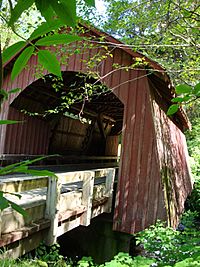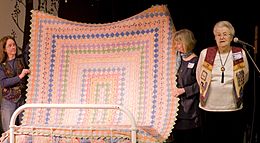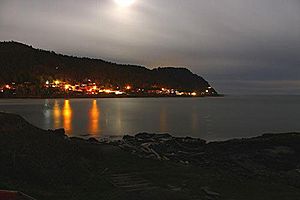Yachats, Oregon facts for kids
Quick facts for kids
Yachats, Oregon
|
|
|---|---|
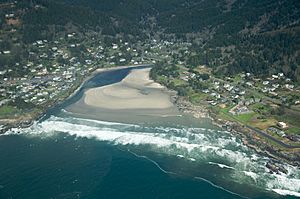
Aerial view of Yachats
|
|
| Nickname(s):
Home of the World's Largest Ocean
|
|
| Motto(s):
Gem of the Oregon Coast
|
|
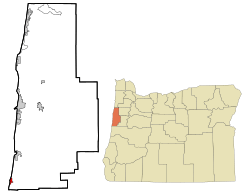
Location in Oregon
|
|
| Country | United States |
| State | Oregon |
| County | Lincoln |
| Incorporated | 1967 |
| Area | |
| • Total | 0.92 sq mi (2.39 km2) |
| • Land | 0.91 sq mi (2.36 km2) |
| • Water | 0.01 sq mi (0.03 km2) |
| Elevation | 45 ft (13.7 m) |
| Population
(2020)
|
|
| • Total | 994 |
| • Density | 1,091.11/sq mi (421.43/km2) |
| • Demonym | Yachatian (yah-HAY-shun) |
| Time zone | UTC-8 (Pacific) |
| • Summer (DST) | UTC-7 (Pacific) |
| ZIP code |
97498
|
| Area code(s) | 541 |
| FIPS code | 41-84200 |
| GNIS feature ID | 1152681 |
| Website | [1] |
Yachats (pronounced YAH-hahts) is a small city right on the coast in the southern part of Lincoln County, Oregon, United States. The name "Yachats" comes from the Siletz language. It means "dark water at the foot of the mountain." Another idea is that it comes from the Alsea word yáx̣ayky. In 2020, about 994 people lived in Yachats.
Contents
History of Yachats
Archeologists have found signs that people lived in the Yachats area for at least 1,500 years. For example, a very old house found here dates back to about 570 AD. Yachats is built on old piles of seashells and many graves left by its first inhabitants. When people built new buildings or roads like U.S. Route 101, they found many old bones and tools.
Early Native American Life
For many centuries, the Native Americans here were hunter-gatherers. This means they moved around to find food, living in summer camps and winter homes. The Alsea Tribe had about 20 permanent villages along the Alsea River and the central Oregon coast. Evidence shows there was an Alsea village, called the Yahuch band, right on the coast at the Yachats River. By 1860, the Yahuch band had disappeared. Many people had gotten sick from European diseases like smallpox.
In the early 1860s, the U.S. Army wanted to open up land in the Coos Bay area for new settlers. They made the Coos and Lower Umpqua Native Americans walk about 80 miles (129 km) north. They walked over rough land to the Alsea Sub-Agency reservation in Yachats. These peaceful people were treated like prisoners. Amanda's Trail is named after a blind Native American woman who suffered greatly on this march. This trail was opened on July 19, 2009. It climbs 800 feet (244 m) from downtown Yachats to the top of Cape Perpetua. From there, it connects to many other trails in the Siuslaw National Forest.
Challenges and Changes for Native Americans
In Yachats, the Native American tribes who used to hunt and gather were forced to learn farming. Crops planted near the ocean did not grow well. This led to very difficult times, and many people died. About 300 Native Americans died in just 10 years. Twelve years after the Alsea Sub-Agency opened, the Native Americans were allowed to create a trail and start farms up the Yachats River Valley. There, they could grow potatoes, oats, wheat, and corn. They were also allowed to hunt again.
Once the Native Americans had built new lives, the U.S. government opened the area for new settlers in 1875. The Native Americans were forced to move again. Some went back to their old homelands. Others went 40 miles (64 km) north to the Siletz Reservation. This move was very hard for many people, and some did not survive.
Growth of Yachats Town
New settlers used the Native American farms and trails to develop the Yachats area. In 1892, the first post office opened in Yachats. It was called Oceanview until 1917, when it was renamed Yachats. Before a paved road was built, rain made it impossible to deliver mail by car. The Roosevelt Memorial Highway, now Highway 101, was carved out of the rock of Cape Perpetua in 1931. This road opened a path from the town of Florence.
Even with early travel difficulties, tourism started in 1905. An old warehouse was turned into the first hotel. Today, tourism is the main business in Yachats.
Yachats During World Wars
Yachats played a part in both world wars. During World War I, spruce wood was needed for airplanes. In 1918, the U.S. Army Signal Corps started logging an area north of Yachats. A 23.5-mile (37.8 km) logging railroad was built to transport logs. It was finished on November 8, 1918, just three days before the war ended. Logs could then be floated to a mill in Toledo, Oregon. A private company bought the railroad and built a large logging camp called "Camp 1" north of Yachats in 1922. This camp had workshops, bunkhouses, a school, and more. Logging continued in the area until 1937.
Early in World War II, a shelter near the top of Cape Perpetua was used to watch for enemy submarines and planes. In Yachats, small trenches and gun spots were set up along the ocean drive. Soldiers stayed in a local skating rink. After the war, the U.S. Coast Guard found Japanese mines that had floated onto the beaches. These were taken out to sea and destroyed safely.
The Little Log Church Museum
The Little Log Church is a historical museum that shows many items from Yachats's past. The church was built in 1926 and designed in the shape of a cross. Sir Robert Perks, who owned much of Yachats then, gave the land. Logs were donated, and local people helped build it. The city now owns the museum.
Population and People

| Historical population | |||
|---|---|---|---|
| Census | Pop. | %± | |
| 1970 | 441 | — | |
| 1980 | 482 | 9.3% | |
| 1990 | 533 | 10.6% | |
| 2000 | 617 | 15.8% | |
| 2010 | 690 | 11.8% | |
| 2020 | 994 | 44.1% | |
| U.S. Decennial Census | |||
In 2020, the population of Yachats was 994 people. The city has grown steadily over the years. In 2010, there were 690 people living in 400 homes. Many people living in Yachats are older adults. The average age in the city was 62.3 years.
What Yachats Does for Money
The main ways people make money in Lincoln County are from lumber, fishing, tourism, and making food products. For Yachats specifically, tourism is the most important business. Many people visit Yachats to enjoy its beautiful coast and outdoor activities.
Geography and Weather
Yachats is the southernmost city in Lincoln County. It has the Central Oregon Coast Range mountains to its east and the Pacific Ocean to its west. To the south, a rugged part of U.S. Route 101 connects Yachats to Lane County. Yachats is about 23 miles (37 km) north of Florence and 23 miles (37 km) south of Newport. It is also 8 miles (13 km) south of Waldport. The city sits on both sides of the Yachats River and its estuary. The total area of Yachats is about 0.92 square miles (2.39 square km).
| Weather chart for Yachats | |||||||||||||||||||||||||||||||||||||||||||||||
|---|---|---|---|---|---|---|---|---|---|---|---|---|---|---|---|---|---|---|---|---|---|---|---|---|---|---|---|---|---|---|---|---|---|---|---|---|---|---|---|---|---|---|---|---|---|---|---|
| J | F | M | A | M | J | J | A | S | O | N | D | ||||||||||||||||||||||||||||||||||||
|
10
51
39
|
8.7
54
39
|
7.7
55
40
|
4.9
57
41
|
3.7
60
45
|
2.7
63
48
|
1
65
51
|
1
66
51
|
2.4
65
49
|
5.1
61
45
|
11
55
42
|
11
51
39
|
||||||||||||||||||||||||||||||||||||
| temperatures in °F precipitation totals in inches source: Weather.com/Yachats |
|||||||||||||||||||||||||||||||||||||||||||||||
|
Metric conversion
|
|||||||||||||||||||||||||||||||||||||||||||||||
The weather in Yachats is usually mild all year because of the ocean. Temperatures rarely go below 30°F (-1°C) in winter or above 75°F (24°C) in summer. The highest temperature ever recorded was 100°F (38°C) in July 1961. The lowest was 1°F (-17°C) in December 1972. Snow is rare. However, it rains a lot during the winter months. Strong storms often come from the Gulf of Alaska each winter.
Fun Things to Do and See
Yearly Events and Festivals
The Yachats la de da Parade happens every July 4th at noon. Anyone in town can join! Fun groups like the Yachats Umbrella Drill Team and a belly dancing troupe often participate. The Yachats Fire Department truck even brings miniature Dalmatian goats. After the parade, the Yachats Youth and Family Activities Program (YYFAP) holds a rubber duck race in the Yachats estuary. In the evening, there is a big fireworks show over the ocean.
The Yachats Music Festival brings 20 to 30 famous classical musicians to Yachats each July. They perform in four concerts over a weekend. This festival has been happening every year since 1981.
Every October, Yachats hosts the Yachats Village Mushroom Festival. Top experts on mycology (the study of mushrooms) share exhibits, give talks, and lead walks in the forest. You can also learn how to grow your own mushrooms. Restaurants in Yachats offer special meals made with wild mushrooms. You can find mushroom-themed art and music around town too.
During the first weekend of November, the city has the Yachats Celtic Music Festival. Musicians from Scotland, Ireland, Canada, and the U.S. perform in different places, including the Yachats Commons auditorium. You can also take workshops to learn Celtic dances or how to play instruments like the bodhran (a type of drum) and the tin whistle.
At the Cape Perpetua Scenic Area, the visitor center holds Whale Watching Weeks in winter and spring. About 400 gray whales feed along the coasts of Oregon, Washington, and British Columbia in the summer. You can often see these whales close to shore from July through mid-November. The visitor center also has a Tidepool Discovery Days program each summer. They offer guided walks to explore the tidepools. The Heceta Head Lighthouse, about 13 miles (21 km) south of Yachats, has a Victorian Christmas Open House every December. You can tour the historic lighthouse and see the keeper's house decorated in a Victorian style. Visitors enjoy holiday music and treats.
Museums and Interesting Places
The Little Log Church and Museum was built in 1926. It was first a church and is now a museum. It holds many local historical items. It's also a popular place for weddings, concerts, and art shows. Every Valentine's Day, couples can renew their wedding vows there.
The North Fork of the Yachats Bridge is a covered bridge in the Yachats River Valley. It's about 9 miles (14 km) east of Yachats. It was finished in 1938. A new version of the bridge was built in 1989, and another in 2014. It cost over $750,000 to rebuild it for tourism. This bridge uses a special "queen-post truss" style. It has openings under the roof to let light into the middle of the bridge. It is 42 feet (13 m) long, making it one of the shortest covered bridges in the Pacific Northwest.
The Yachats 804 Trail used to be a main path between Yachats and Alsea Bay in Waldport, 8 miles (13 km) north. For centuries, Native Americans used it to travel between the bay and the Yachats River, but only at low tide. Later, it was called County Road 804 and used for carriages until Highway 101 was built in the 1930s. Today, this historic trail is a walking path with views of crashing waves, tidal pools, and local plants. It is part of the Oregon Coast Trail system. It goes 0.75 miles (1.2 km) north from a parking area in Smelt Sands State Recreation Area.
The Yachats Community Presbyterian Church has six special windows. They are made of gold-colored agates collected from local beaches. These windows cover 217 square feet (20.2 square meters). They are thought to be the only windows in the world made of agate.
The Yachats Commons was built in the 1930s and was a school until 1983. In 1990, the city bought it to be a community center. It now holds city offices and many events. These include free movie nights, play readings, drum circles, senior luncheons, and concerts by the Yachats Big Band. The Oregon Coast Chamber Orchestra and local theater groups also perform there. Art and craft shows are held at the Commons. From May to October, it hosts the outdoor Yachats Farmers Market.
The Yachats Academy of Arts & Sciences puts on many educational and fun events, mostly at the Commons. They have speakers, films, workshops, and seminars about art, science, and other topics.
The Commons is also where locally filmed movies have their first showings. The Yachats International Film Festival focuses on making and showing these films. One example is Ghoul from the Tidal Pool. This funny horror movie was made by local volunteers.
The Yachats Public Library has a changing display of paintings, drawings, and photos by the Yachats Arts Guild. The library also has the Yachats Seed Bank. This is a collection of vegetable seeds given for free to gardeners. The Seed Bank also has many cookbooks, gardening guides, and books about making the community more sustainable. The library offers free Wi-Fi and computers for public use. Visitors can get a library card and check out books while on vacation.
Parks and Outdoor Fun
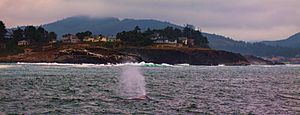
The Yachats area has many different plants and animals. It's a great place to study ocean, mountain, and riverbank ecological communities and how they interact. The following natural places help protect and show off the plants and wildlife of the central Oregon coast.
Exploring Nature in Yachats
The Siuslaw National Forest is next to Yachats on the east. It covers over 630,000 acres (2,550 square km). This is about five-eighths the size of Rhode Island. It stretches from Coos Bay in the south to Tillamook in the north. The forest has many hiking trails. Some go through old growth forests of Sitka spruce, western hemlock, and Douglas fir in the Cummins Creek and Rock Creek Wilderness areas, a few miles south of Yachats. Other trails north of Yachats lead to mountain tops like Cannibal Mountain.
The Siuslaw National Forest includes Cape Perpetua, about 2 miles (3.2 km) south of Yachats. Captain James Cook named it on March 7, 1778. This point rises 803 feet (245 m) above sea level, making it the highest spot on the Oregon coast. Its West Shelter is a popular place to watch gray whales migrating. At the bottom of the cape, powerful waves have carved a rough inlet called the Devil's Churn. On the north side of the cape, you can see the Cleft of the Rock Lighthouse from Highway 101.
Yachats Ocean Road State Natural Site is on the south side of the Yachats River mouth. It's a 1-mile (1.6 km) strip along the river's estuary and the ocean. There are picnic tables, and stairs lead down to the beach. At Agate Cove, waves crash against the rocks, creating amazing spouts from blow holes.
Yachats State Recreation Area is a park on the north side of the Yachats River mouth. It has a viewing deck that sticks out from the headlands, about 0.25 miles (0.4 km) west of downtown Yachats. It's a great spot to watch whales and other wildlife, explore tide pools, fly kites, fish, and have picnics. Restrooms are available.
Smelt Sands State Recreation Site is a beach on the northern edge of Yachats. In the past, many smelt (small fish like salmon) would come ashore here during their yearly runs. These runs have become smaller recently. You can reach the beach by walking the historic 804 Trail, which is 0.75 miles (1.2 km) long, from the parking area. In January 2013, a Coastal Safety Marker was put in Smelt Sands State Park. It reminds visitors about the danger of sneaker waves. The marker tells the story of two high school students who drowned here in 2011 after being hit by a sneaker wave.
Yachats Community Park is a restored marshland in the center of the city. The park has boardwalks and paths where you can see many native plants and wildlife. This includes a preserved spruce forest. Migrating waterfowl visit the wetlands often, and ospreys nest on platforms built for them. The park also has a picnic shelter, a peace garden, a tree house, and benches.
Gerdemann Botanical Preserve is a 3.5-acre (1.4 ha) native woodland on the northern edge of Yachats. It's also on the western edge of the Siuslaw National Forest. This garden protects the plant collection of James and Janice Gerdemann. Among the native Sitka spruce and western hemlock, the garden is a special outdoor lab. It has many unique plants from other countries, like South African honeybush, New Zealand tree ferns, and Chilean flame trees. Today, the garden is used for plant research and education.
Ten Mile Creek Sanctuary is a 216-acre (87 ha) protected area about 7 miles (11 km) south of Yachats. This forest of Sitka spruce and western hemlock is home to special birds like the marbled murrelet and northern spotted owl. Other animals here include Roosevelt elk, black-tailed deer, cougar, black bear, and bald eagle. Ten Mile Creek has runs of steelhead trout, Chinook salmon, and threatened coho salmon. The Audubon Society manages the sanctuary. They offer many educational programs and work to protect nature.
Schools and Learning
Yachats is part of the Lincoln County School District. Students from kindergarten to eighth grade go to Crestview Heights School in Waldport. High school students (ninth to twelfth grade) attend Waldport High School. The closest colleges are Oregon Coast Community College in Newport and Lane Community College in Florence.
News and Media
The Yachats Gazette is a newspaper published every month. It provides local news, interviews, and stories about people, businesses, and attractions. You can read it in print or online. Two other newspapers also cover the Yachats area: the South Lincoln County News and the Newport News-Times. There are no local radio or television stations in the Yachats area.
City Services
Yachats is located on U.S. Route 101. In 2017, changes to Highway 101 shoulders caused some traffic issues. Some locals joke that Yachats is "the biggest little traffic jam on the Oregon coast." The closest airport is Wakonda Beach State Airport, a grass airstrip near Waldport. Yachats does not have train service. However, local bus transportation is provided by Lincoln County Transit.
The City of Yachats provides water and sewer services. Drinking water comes from Salmon and Reedy creeks. Central Lincoln Public Utility District provides electricity. Pioneer Telephone Cooperative provides telephone service. Private companies handle trash disposal and cable TV.
The closest hospitals are Samaritan Pacific Communities Hospital in Newport and Peace Harbor Hospital in Florence. Health care is also available in Waldport at Waldport Family Medical Center and other clinics.
The Yachats Rural Fire District has three fire stations. The Lincoln County Sheriff's Department and the Oregon State Police provide law enforcement.
See also
 In Spanish: Yachats para niños
In Spanish: Yachats para niños


